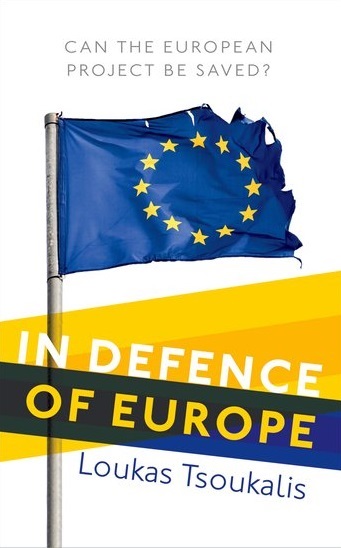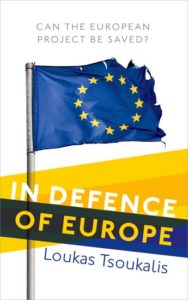

Due to the Euro crisis, the Eurozone has become divided between a relatively wealthier, more successful core—considered to consist of Austria, Finland, France, Germany, and the Netherlands—and the economically disadvantaged periphery—composed of Greece, Ireland, Italy, Portugal, and Spain. Support for the European project is at its all-time low. Economic growth and wellbeing is yet more unevenly distributed across the continent. Together with increasing levels of immigration and threat from terrorism, these multiple crises have led nationalism and populism to rise virtually everywhere on the Old Continent. As a consequence, the already weakening permissive consensus that characterized European integration has received another strong blow in the aftermath of the crisis. Europe is becoming, yet again, an increasingly divided place.
“Can Europe overcome its internal divisions and face a growing number of challenges?” This is the central question raised by Professor Loukas Tsoukalis in his latest book In Defence of Europe (17). To answer this question, Tsoukalis retraces the history of European integration from the Schuman Declaration of 1950 to the present day, providing a balanced analysis of what went wrong along the way. The second chapter provides a brief summary of the main stages of the European project, before moving on to the last decade. Indeed, the book pays particular attention to the period running between the global financial crisis of 2008 throughout the Euro crisis, covered in chapters three and four. In the last chapter, Tsoukalis dares to make a number of seemingly accessible policy suggestions to save the European project, which however would demand heroic political efforts by all the parties involved. Analytically very rich, the book stands between International Relations (IR), Political Science and Political Economy. Indeed, Tsoukalis is able to successfully reconcile the use of IR categories such as balance of power or the focus on states as the unit of analysis while also using a political science perspective to explore the internal political dynamics of individual member states. This analysis is then glued together by a political economy approach, examining the “connections between economics and politics, markets and power, efficiency and distribution” (17).
Tsoukalis maintains a pronounced critical view of certain key aspects of European governance both at EU and domestic level, which according to the author are tearing the Union apart.
Tsoukalis maintains a pronounced critical view of certain key aspects of European governance both at EU and domestic level, which according to the author are tearing the Union apart. On the one hand, Tsoukalis blames the incomplete and flawed institutional design of the euro, the extreme fiscal straightjacket imposed by the Treaty of Maastricht and the Fiscal Compact, and the lack of democratic accountability—the latter in particular with regards to the management of the single currency. On that respect, he argues that European integration has become an “ever bigger, more [politically] intrusive and less [socially] inclusive” project (21). On the other hand, the author highlights the narrow short-term interests of individual states: from Germany’s stubbornness on fiscal and monetary stances to Greece’s instances of clientelism and corruption. Quite distinctively, however, Tsoukalis’s main contribution to the debates on the Euro crisis and the future of the Union lies within his examination of the interplay between the processes of European integration and the ever-changing dynamics of globalization, a theme running throughout the entire book. The central claim is that the European project has essentially failed to adequately manage globalization to the benefit of society at large (179). With the outbreak of the recent crisis, the division between the winners and losers of European integration and globalization has become starker than ever before. European integration and globalization are conceived by Tsoukalis as closely interconnected, whereby the losers see those two processes as essentially indistinguishable (151). Almost counterintuitively, though, globalization takes two, almost conflicting roles in Tsoukalis’s analysis. Indeed, the book treats the interdependent developments of globalization as having been caused to a large extent by the process of European integration. At the same time, globalization is seen as one of the challenges that individual European countries would not be able to face should the EU disintegrate. While the author recognizes the contingent nature of both the EU and of globalization, his views are unclear as to what would happen to the processes of interdependence and globalization should the European project actually fall apart: Would they still exist in their current form? If not, would globalization still pose a serious challenge to individual European states?
Despite these unanswered questions, Tsoukalis develops a very worthy analysis of the relationship between globalization and European integration. One of the key claims is that, especially following the crisis, the division of labor between open markets at European level and social protection provided by national welfare states—the implicit European social contract—has been broken by very low or inexistent growth, years of austerity, rising unemployment, and less secure job prospects (155). At a time where the EU is no longer perceived to be providing some public goods, rising popular discontent towards European integration has paved the way for nationalism and Euroscepticism. More specifically, pressures on social protection and the “never-ending almost zero-sum game of competitiveness played out in a fast globalizing world” (180) were exacerbated by the flawed design of the euro and the policy responses to the euro crisis.
Tsoukalis is unforgiving about how the euro was designed, albeit well aware of the necessary political compromise, which emerged from the French and German positions with regards to the creation of a single currency. The combination of the disinflationary monetary regime instated with the Treaty of Maastricht, the European internal market and the different labor market regulations of individual member states has allowed for: 1) the loss of competitiveness in the Eurozone periphery; 2) the crystallizations of trade imbalances between the surplus, export-oriented core and the deficit, bubble-driven periphery; 3) a dangerous vicious cycle of debt- and bubble-driven growth regimes in the periphery (particularly in Spain and Ireland), which broke down when the 2008 credit crunch arrived to Europe. Tsoukalis firmly holds that the dangerous link between member states and banks, caused to a large extent by the national bailouts, was worsened by the lack of a single political authority to act on behalf of the entire Eurozone, the absence of an agreed sets of rules and of a lender of last resort (as the EU Treaties prevent the European Central Bank from acting as one) (70). However, the policy responses to the crisis mostly ignored that the asymmetric design of the European Monetary Union was part of the problem affecting the entire Eurozone. As a consequence, the vast majority of the adjustments were borne by the deficit countries of the periphery. The adjustments took the form of German-inspired and biased structural reforms (liberalization and privatization), punitive austerity measures, reduction of real wage growth and even tighter fiscal restrictions. Tsoukalis argues that these policy responses were trying to achieve incompatible goals: internal devaluation in order to improve competitiveness, which induced a decline of real GDP, while simultaneously trying to clear excessive levels of sovereign debt-to-GDP ratios (112). “Toxic politics and flawed economics” is what characterized the handling of the Eurozone crisis, claims the author (111), leading to worsening living standards in the periphery and fostering popular discontent towards the EU.
Another key issue raised by Tsoukalis is the change in the European balance of power that became evident during the course of the crisis, dealt with in detail in chapter five. France, the historical driver of the process of European integration, has slowly stepped back from its leading role and become more disillusioned with the ever increasing liberal direction the EU has taken in the last two decades. Germany, the indisputable hegemon during the crisis, has been “successful but reluctant to lead” (118) because of the high domestic political sensibility that surrounded the bailouts programs. Finally, the British question. At the time of the book’s publication, the (in)famous Brexit referendum had not yet taken place. However, Tsoukalis’ reflections may still provide important insights concerning the future relationship between Europe and the UK. Indeed, he claims that the dissatisfaction Britain has towards the EU may actually be the consequence of the Brits’ confusion between the sovereignty constraints deriving from EU membership with the constraints originating from rising European and international interdependence. Should the British people choose (as they did) to disentangle themselves from EU-related constraints, will they be able to do the same with the sovereignty restrictions imposed by globalization? (145).
Beyond discussing the challenges that Europe faces from within, Tsoukalis is also aware of the risks from without, which is the focus of chapter six. Membership enlargement (considered by the author as the EU’s only successful foreign policy tool) has been strongly downplayed by Russia’s resurgence in global politics, following its assertion of hard power in Ukraine (166). In other words, the EU’s influence in its neighborhood, the so-called Pax Europea based on soft power, does not extend limitlessly. The issue of immigrants and refugees is the other external challenge that Tsoukalis recognizes as a threat to the integrity of the European project. The year 2015 witnessed a peak of refugees and illegal migrants arriving onto the EU’s southern borders (mainly Greece and the southern Italian islands), which unfortunately coincided with a period of increasing social and economic discontent in the Old Continent. The political difficulty to manage such a large wave of immigration, Tsoukalis claims, has raised concerns of national identity and cultural homogeneity within a specific section of European society, usually made up by older men from a low-income background and less educated (158). Nationalism emerged as a reaction, usually accompanied by Eurosceptic sentiments and xenophobia.
Nationalism emerged as a reaction, usually accompanied by Eurosceptic sentiments and xenophobia.
The future of Europe, as narrated in In Defence of Europe, does not look that bright. Yet, Tsoukalis leaves a small window of hope. The last chapter of the book is dedicated to some proposals that, according to the author, could perhaps reverse the current disintegrating trend of the EU by making European integration more socially and institutionally sustainable. The policy suggestions include: 1) a fiscal union with automatic stabilizers to prevent further macroeconomic imbalances within the Eurozone; 2) taking advantage of low interest rates to implement a large investment plan targeted at infrastructure, education, training and innovation; 3) a more relaxed fiscal stance in Germany and a larger Quantitative Easing by the European Central Bank; 4) a European-wide unemployment insurance scheme to complement the national counterparts; 5) a financial transaction tax (the so-called Tobin Tax) and more taxation in general, seen by Tsoukalis as one of the areas in which the EU could play a central role; 6) a parliament for the euro to strengthen the democratic legitimacy of the single currency; 7) a more flexible model of integration, acknowledging that the one-size-fits-all regime does not work anymore, which could go as far as putting into question one of the cornerstones of the European project: free movements of people; 8) strengthening common policy areas in the fields of security, energy and immigration, in order to deal with the challenges coming from the Union’s external borders; 9) lastly, the need for a reliable, long-term leader. Germany could be taking up this role, provided that its politicians and citizens realize that the status quo is no longer sustainable, while France could try to regain its role as co-leader of the project.
Overall, In Defence of Europe is a very well written and easy to read book that is targeted at a wider audience beyond academia. It has successfully condensed the long history of European integration in a relatively short and accessible read (just over 200 pages), combined with a thorough political and economic analysis of the past, current and future challenges of the European project. However, the book is mostly based on a revised analytical summary of the existing literature on European integration, providing limited original contributions. That said, this was probably not the objective Tsoukalis had in mind with this work.
Reviewed by Lorenzo Genito, University of Warwick
In Defence of Europe
by Loukas Tsoukalis
Oxford University Press
Hardcover / 280 pages / 2016
ISBN: 9780198755319
Published on November 1, 2016.




